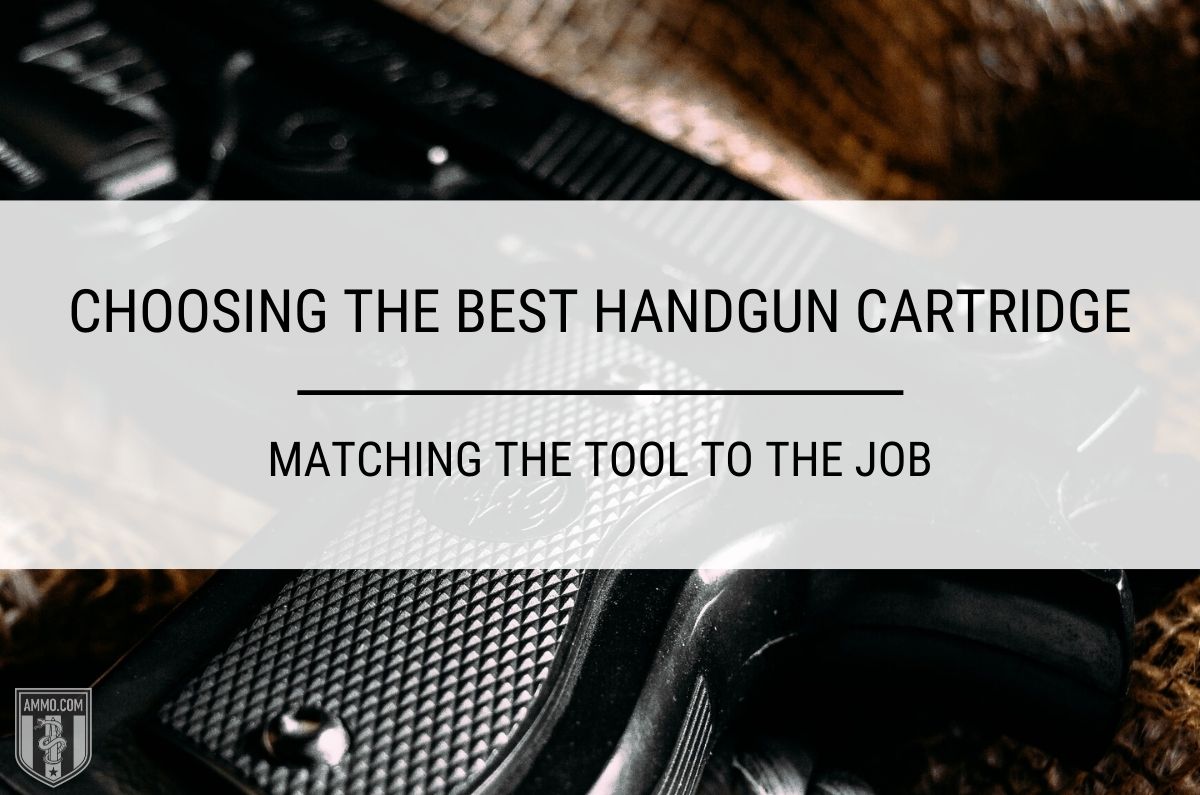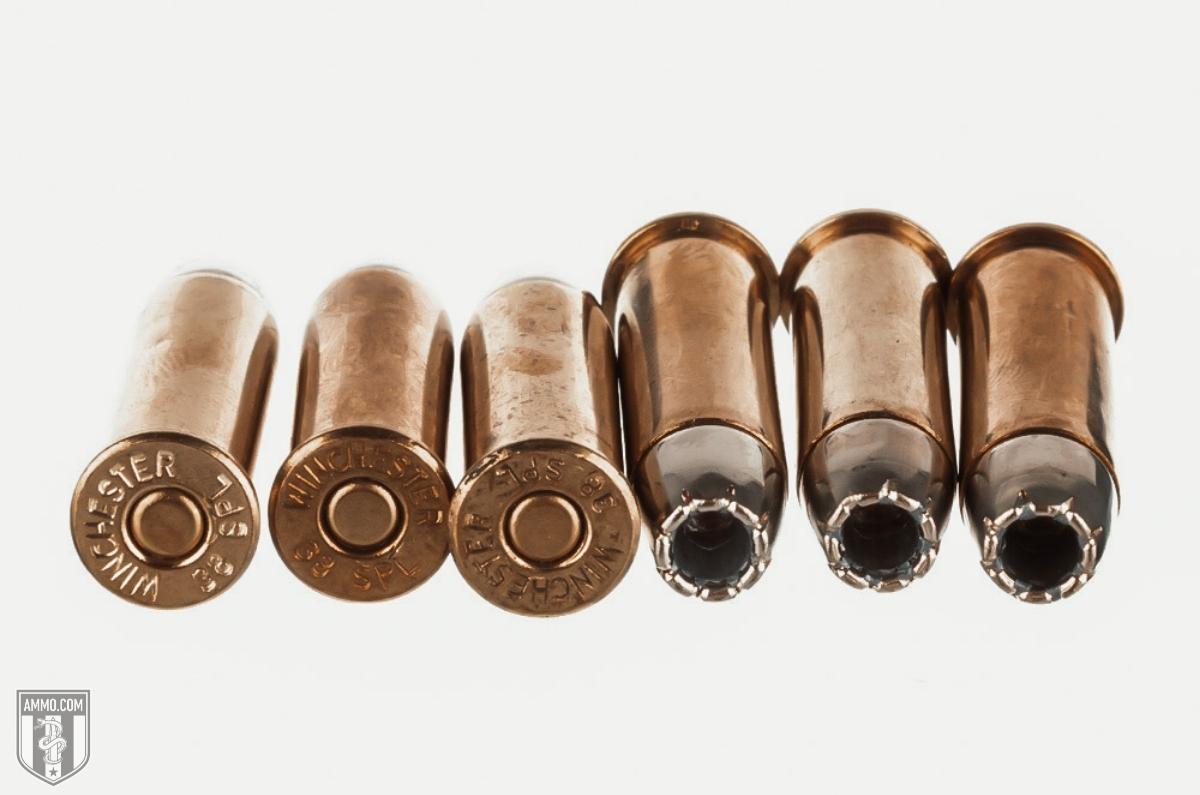Choosing the Best Handgun Cartridge: Matching the Tool to the Job

When it comes to handgun cartridges, what's "best" is subjective. How you intend to use your handgun is the biggest determinant of which round you should prefer. What works best for plinking cans off backyard fenceposts isn’t going to cut it for bear defense.
We outlined the most popular handgun cartridges in current production to help you pair the right one with your shooting discipline. In this article, you’ll find the pros and cons of each option and a description of what each one does best.
.22 LR
The .22 LR is the smallest round on this list. The rimfire cartridge is also the softest-recoiling cartridge we’ll cover, which makes it a great option for introducing young or new shooters to the sport.
Although relatively weak, the .22 LR can be a viable choice for personal protection. It's favored by many who want (A) as little recoil as possible, and (B) the smallest and most easily concealed pistol for personal protection.
As you may already have guessed, correct shot placement is essential when it comes to defense with so weak a cartridge. You would be well advised to choose a bullet which *isn't* designed for terminal expansion. This helps the bullet penetrate deeper into the theat, which increases its odds of striking a vital organ.
.22 LR ammo is inexpensive. Even the high-end stuff only costs pennies a round. If burning through ammo is your idea of a good time, the .22 LR makes for an affordable and fun afternoon of shooting.
Here are a few mild-shooting options to consider when you’re shopping for a new .22 pistol: the Ruger Mark IV, the Browning Buckmark, and the Walther P22.
.380 ACP
The .380 ACP (Automatic Colt Pistol) is a relatively small cartridge, albeit one that fires the same diameter bullets as the popular 9mm Luger (0.355"). The .380 ACP is sometimes called the "9mm Short" or "9mm Kurtz" ("kurtz" being German for "short").
While the .380 ACP packs significantly more punch than the .22 LR, it is still a little wimpy when it comes to “stopping power.” Muzzle energy rarely exceeds 200 ft lbs (for context, a minimum of around 260 ft lbs is typically considered adequate for self-defense).
This cartridge is a popular option for pocket pistols. Many police officers and civilians choose this cartridge for their backup guns.
The recoil from this cartridge is mild, making it manageable for older, disabled, and recoil-sensitive shooters.
If you’re looking for a reliable, easy-to-conceal pocket pistol, check out the Ruger LCP or SIG Sauer P238.
.38 Special
The .38 Special is the brainchild of firearms powerhouse Smith amp; Wesson. Introduced in 1898 as an improvement over the .38 Long Colt, this cartridge was a favorite of police departments for over half a century.
The vast majority of firearms that can fire .38 SPL are revolvers. Models like the Ruger LCR, S&W M&P Bodyguard, and Weihrauch Windicator are affordable, low recoil, and easy to fire.
One of the greatest drawbacks to "wheel guns" is ammo capacity: they typically only hold five or six rounds. If you wind up needing more shots, then you had better hope your assailant gives you enough time to reload.
.357 Magnum revolvers safely fire .38 SPL as well, so buying a sidearm chambered for the bigger cartridge is sort of like getting two guns for the price of one. (That said, a 357 Magnum revolver will weigh more than one that only fires .38 SPL, which has obvious downsides if you intend to carry the revolver around with you all day.
.357 Magnum
The .357 Smith & Wesson Magnum was introduced in 1934. Though it fires the same caliber bullets (0.357"), it is substantially more powerful than its shorter cousin.
The biggest advantage to firing revolvers is that they are more reliable than semi-automatics. With a wheel gun, you don't have to worry as much about your ammo jamming (it's still possible, though, due to "crimp jump" where recoil jerks the bullet out of its seating in the case mouth which can in turn interrupt rotation of the cylinder).
The biggest disadvantage to choosing a revolver like the .357 is its limited ammo capacity. At most, you’re going to have eight shots, and reloading a wheel gun isn’t easy during a stressful scenario (such as when someone is trying to kill you). Condider carrying a speed loader or moon clip if you want to reload a revolver quicker (even with one of these devices, you'll probably reload slower than you would have with a magazine-fed firearm).
The .357 Magnum is substantially more powerful than the .38 Special. It's also substantially more expensive, although that shouldn't discourage you from training with the ammo you may one day entrust your life to.
The .357 Magnum’s recoil can be difficult to handle, especially when you’re firing a smaller wheel gun. Using a heavier model with at least a 6" barrel will help soak up some of the cartridge’s snappy recoil.
We recommend the Ruger Model SP-101 or the Colt Python.
9mm Luger
The 9mm Luger (also known as the 9x19mm Parabellum, or simply 9mm) is the most popular handgun cartridge for both law enforcement and civilian self-defense.
Although the 9mm was once criticized as being too weak for self-defense, improved propellant and bullet technology have left basically nothing to be desired about its performance.
Today, the 9mm is considered the gold standard of defensive handgun cartridges. It offers a near-perfect balance of velocity, power, and "shootability." When topped with expanding jacketed hollow point (JHP) bullets, the cartridge produces wide wound channels and enough penetration to reach vital organs.
Popular 9mm pistols include the several models produced by Glock, as well as the Smith & Wesson M&P Shield, SIG Sauer P365, and Ruger LC9s. Options range from pistol caliber carbines (PCCs) to subcompact concealed carry models and everything in between.
Because everyone and their brother is in love with the 9mm Luger, there are plenty of ammo options on the market. You won’t find this kind of variety for any other cartridge. Shooters can choose from a wide range of bullet weights and designs.
Because demand also drives pricing, 9mm ammo for both practice and protection is relatively affordable. The low cost of 9mm ammo allows you to put in enough range time to tone up your marksmanship without worrying too much about your bank account.
.40 Smith & Wesson
The .40 Smith & Wesson was designed in the wake of the infamous 1986 Miami Dade shootout that ended with the deaths of two FBI agents. Another five FBI agents were injured in a standoff against bank robbers armed with two .357 Magnum revolvers, a Ruger Mini-14, and a 12 gauge shotgun.
The new pistol cartridge was engineered to deliver better terminal ballistics than the 9mm, but in a platform that was easier to fire than the FBI’s 10mm Auto. (Many agents of the day had a difficult time qualifying with the hard-recoiling 10mm.)
Although the .40 S&W was once a popular law enforcement cartridge, it is on its way out. More and more shooters – civilian and operator alike – are dropping .40 S&W in favor of the 9mm.
There are still plenty of shooters who swear by the .40 S&W, though. While the muzzle velocity of the .40 S&W is similar to the 9mm, the .40 hits the target with far more energy, driving deeper into soft tissue as a result. And when neither bullet achieves terminal expansion, the .40 cal necessarily inflicts a wider wound channel than the 9mm.
Although the .40 S&W produces less recoil than its 10mm predecessor, it is still a pretty heavy hitter. Even in a full-size pistol, the .40 S&W’s recoil can be snappy and hard to tame, which can make getting back on target for quick and accurate follow-up shots a bit problematic for some.
The 40 S&W is no longer in its hayday, althoguh many major firearm manufacturers do still produce pistols for it. Some quality options currently in production include the Glock 22, Sig Sauer P226, Taurus G2c, and Springfield Armory XD-S.
Because it takes more raw materials to manufacture bigger cartridges, .40 S&W is typically more expensive than comparable 9mm rounds. The lower demand for .40 S&W loads also drives the price up, so expect to invest more in both your FMJ practice loads and your self-defense ammo.
Given these cost considerations, buying bulk .40 S&W ammo can be a wise investment.
10mm Auto
The bigger, older brother of the .40 S&W, 10mm Auto was introduced in 1983. It was initially designed by Norma Precision for the Dornaus & Dixon Bren Ten semi-auto pistol. The cartridge was engineered to shoot faster and flatter than the .45 ACP, as well as deliver more striking energy and wider wound channels than the 9mm Luger.
The 10mm Auto produces tons of energy, which many consider too much to be a practical personal defense round. Over -enetration can be a serious issue when using this cartridge for home defense. Rounds that go straight through bad guys can cause serious collateral damage.
If part of your personal protection plan includes possible encounters with big grizzlies, the 10mm Auto makes a capable bear defense cartridge, especially when your ammo is topped with heavyweight hard cast bullets.
As a backcountry sidearm, the 10mm Auto brings plenty to the table. It delivers lots of power, shoots reliably and consistently, and has mag capacities that reach near 15 rounds so you'll have plenty to lob at a charging bruin.
The recoil on this one is pretty harsh, even for some experienced shooters. The FBI actually dropped the 10mm because their agents couldn’t pass competency tests with their duty pistols.
The 10mm Auto has largely fallen out of favor among law enforcement personnel, though it hasn’t completely gone the way of the dinosaur. Although the cartridge (and the guns chambered for it) are considerably more obscure than they were a few decades ago, both are seeing a modest resurgence in popularity.
The most popular models include the SIG Sauer P220, Glock 40, and the Colt Delta Elite.
.44 Remington Magnum
The .44 Remington Magnum (also known as .44 Magnum, 44 Mag, or just "44") is best known for its association with a movie character. (You know which one, punk.)
The .44 Magnum was once touted as the most powerful cartridge in the world. Since its introduction in 1954, mstronger cartridges have hit the market. However, the .44 Magnum remains a potent option for shooters who live by the motto “Go big or go home.”
The .44 Magnum is usually housed in a big bore revolver. That means you’ll only get about five or six rounds before you need to reload.
Those five or six rounds are going to hit with a massive amount of energy, however. That stopping power is a major perk if you find yourself toe to toe with an angry bear.
Because the .44 Magnum hits with such force, it also has some seriously harsh recoil. It takes some muscle (and sometimes some courage) to tame this one.
A few popular revolvers chambered for .44 Magnum include the Ruger Super Redhawk, Taurus Raging Bull, and Smith & Wesson Model 69.
.45 ACP
The .45 ACP (Automatic Colt Pistol) was engineered by John Moses Browning to go with his iconic Colt Model 1911 semi-auto pistol. The cartridge and 1911 were both used by the U..military for decades. Fans of the .45 ACP regularly brag about it being the cartridge “that won two world wars.”
The cartridge fires a 230 grainn bullet. Although those projectiles only reach velocities around 850 fps, they tote ample energy for defense downrange. Go figure: our miltary's longest-used pistol cartridge is effective at its only purpose.
The .45 Auto also features larger diameter bullets than most other popular handgun calibers. Straight from the muzzle, these bullets already measure .45 inches wide. Add a bullet design that produces double diameter expansion and this cartridge punches big holes in bad guys.
The best part about the .45 ACP is that it manages to deliver all that power and expansion without creating excessive recoil. While this might not be the cartridge to hand your 90-year-old granny, its recoil is manageable for most shooters. Its recoil is actually not much heavier than the 9mm’s.
The .45 ACP is a pretty bulky cartridge. Only makes sense that guns chambered for it are a bit on the bulky side as well. Although these sidearms aren’t easy to conceal, they make excellent home defense pistols.
The .45 ACP’s largish dimensions take up magazine space, so firing a pistol chambered for this bigger round is going to cost you at least a few slots of magazine capacity. Most 1911-style pistols only hold around 7+1 rounds. If you go for a larger semi-auto, like the G21, you’ll get three more rounds.
Although Glock’s G21 is a popular law enforcement duty pistol, the .45 ACP cartridge is practically synonymous with the Model 1911. The two go together like peas and carrots. If you want a classic pairing, the Ruger SR1911, Kimber Warrior, and Colt Royal Blue 1911 Classic do not disappoint.
Feeding your pistol .45 ACP ammo is also going to cost you. Some loads run twice the price of 9mm ammo in the same product line. However, .45 ACP won’t cost you nearly as much as big bore cartridges like .44 Magnum, and you can always save a few bucks by buying in bulk.
Final Thoughts
In this article, we covered the most popular handgun cartridges on the market today. This is by no means an exhaustive list. There are many other fine options available to modern shooters, but they may be a little more difficult to get your hands on.
The best handgun cartridge is the one you can fire with confidence. If you can put several 22 LR into the threat, then you'll probably be better off than if you'd missed altogether with anything else.
Cartridge Recommendations
- Best Caliber for Deer Hunting
- Best Big Game Caliber
- The 10 Best Coyote Cartridges
- Best Cartridge for Elk Hunting
- Best Cartridge for Self-Defense
- Best Cartridge for Concealed Carry
- Best Handgun Cartridge
- Best Moose Cartridges
- Best 40 S&W Ammo For Self Defense & Target Practice
- Best 223 Ammo
- Best .44 Magnum Ammo
- Best Shotgun Shell Types for Home Defense & Hunting
- Best 270 Ammo for Hunting
- Best 17 HMR Ammo for Varmint Hunting and Plinking
- Best 22 Rimfire Ammo
- 4 Best AK-47 Ammo Picks [7.62x39]
- Best 38 Special Ammo for Self Defense
- Best Handgun Ammo for Self-Defense in Common Calibers
- Best 308 Ammo For Hunting & Target Shooting
- Best 300 Win Mag Ammo
- Best 243 Ammo for Target Shooting
- 10 Best 6.5 mm Cartridges For Long-Range Shooting and Hunting
- Best 45 ACP Hollow Points for Self-Defense
- Best 12 Gauge Ammo for Home Defense
- Best 32 ACP Ammo for Your Pocket Pistol or Backup Gun
- Top 13 Best AR Calibers That Aren’t 5.56 NATO
- Best Ammo for Smith and Wesson M&P 9mm Shield
- Best 7.62x39 Ammo for Self Defense
- Best 20 Gauge Ammo for Home Defense, Whitetail, and Upland Game
- Best Ammo for 1911 45 ACP
- Best 12 Gauge Ammo for Deer Hunting
- Best .40 S&W Ammo for Self Defense
- Best 7.62x39 Hunting Ammo
- Best 5.56 Ammo for Home Defense
- Best 380 Self-Defense Ammo
- Best 45 ACP Ammo for Every Situation
- Best Ammo for Glock 43x
- Top 5 Best 22 WMR Ammo on the Market
- Best Ammo for Glock 19
- Best Sniper Ammo
- Best 38 Special Ammo For Target Practice Precision Shooting
- Top 5 Best 45 ACP Ammo for Target Practice
- Best 6.5 Creedmoor Hunting Ammo
- Top 10 Best Sniper Rifle Cartridges
- Best 6.5 Grendel Ammo
- Best 5.45x39 Ammo for Your Gun
- Best 10mm Ammo for Bear Defense
- Best 350 Legend Ammo
- Top 5 Best 30-06 Ammo for Deer Hunting
- Best 30-06 Ammo for Accuracy
- Best 300 Win Mag Ammo for Deer
- Best M193 Ammo for Stockpiling
- Best 300 Blackout Ammo for a 7.5" Barrel
- Best Shotgun Shells for Target Practice
- Best 45 ACP for Bear Defense
- Best 223 for Deer Hunting
- Best Exotic 9mm Ammo
- Best Duck Hunting Shells
- Best .357 SIG Defensive Ammo
- Best Beretta APX 9mm Ammo
- Best 22 Pistol Ammo
- Best 9mm Ammo
- Best 308 Ammo for Deer Hunting
- Best Ammo for the Taurus GX4
- Best Ammo For Taurus PT111 G2
- Best Shells For Trap Shooting
- Best 38 Special Ammo for Snubbies
- Best 410 Ammo For A Taurus Judge
- Best Ammo for Ruger Security 9
- Best Ammo for Taurus G3c
- Best 7mm Rem Mag Ammo
- Best Lead-Free Hunting Ammunition
- Best 300 Blackout Ammo for Hog Hunting
- Best 9mm Home Defense Ammo
- Best 10mm Ammo for Every Shooting Situation
- Best .22 LR Ammo for Self-Defense
- Best Long-Range Hunting Bullets
- Best 357 Magnum Ammo For Every Shooting Situation
- Best 45 ACP Ammo For Self-Defense
- Best 6.5 Creedmoor Ammo For Accuracy
- Best 45-70 Ammo For Hunting & Target Shooting
- Best Turkey Loads
- Deadliest Shotgun Ammo For Home Defense
- Best 300 Win Mag Ammo For Elk Hunting
- Best 9mm Subsonic Ammo
- Best 7mm PRC Ammo









